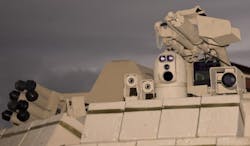HIGH WYCOMBE, England, 24 April 2011. Curtiss-Wright Controls Embedded Computing is introducing the FMC-516 rugged field-programmable gate array (FPGA) mezzanine card for military applications such as signals intelligence (SIGINT), electronic countermeasures (ECM) and radar that need high-speed A/D converter components as part of a digital receiver.The FPGA mezzanine card (FMC) is a quad channel 250-megasample-per-second 16-bit analog input card that enables systems designers to couple I/O devices directly to a host FPGA to make the most of throughput and synchronizes several channels and boards.The FMC-516, which the VITA 57 FMC standard, helps integrate FPGAs into military embedded systems with low latency and high-bandwidth. The FMC-516 has four A/D converters that connect through the module's FMC connector to an FPGA-based host board.
The card supports an onboard programmable sample clock generator and external reference input. Several FMC-516 boards can be synchronized to increase input channels with trigger input/output signals under the control of the FPGA.
The FMC-516 comes in air-cooled and conduction-cooled rugged versions. Software support includes Curtiss-Wright's FusionXF/HDL development kit, which includes software, hardware description language, and utilities.
FMC modules enable FPGAs to connect and control I/O devices on VITA 57 mezzanine cards, and provide small size, reduced I/O bottlenecks, increased flexibility, and reduced cost. The FMC connector provides I/O pins that support high-speed signals for moving data between the FMC and the FPGA.
For more information contact Curtiss-Wright online at www.cwcembedded.com.




